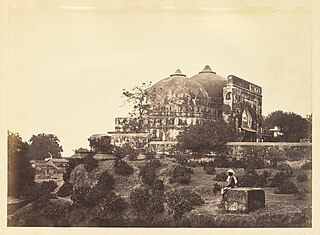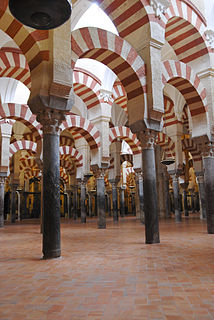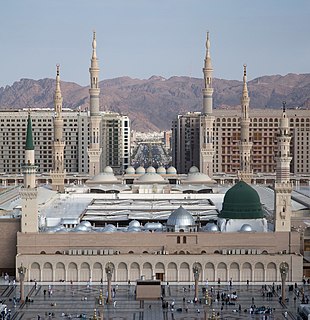This article does not cite any sources .(January 2021) (Learn how and when to remove this template message) |

Haji Rufai Bey Mosque is a mosque in Nakhichevan, Azerbaijan. It was built in the 18th century.
This article does not cite any sources .(January 2021) (Learn how and when to remove this template message) |

Haji Rufai Bey Mosque is a mosque in Nakhichevan, Azerbaijan. It was built in the 18th century.

Bursa is a city in northwestern Turkey and the administrative center of Bursa Province. The fourth-most populous city in Turkey and second-most populous in the Marmara Region, Bursa is one of the industrial centers of the country. Most of Turkey's automotive production takes place in Bursa.

A mosque, also called masjid, is a place of worship for Muslims. Any act of worship that follows the Islamic rules of prayer can be said to create a mosque, whether or not it takes place in a special building. Informal and open-air places of worship are called musalla, while mosques used for communal prayer on Fridays are known as jāmiʿ. Mosque buildings typically contain an ornamental niche (mihrab) set into the wall that indicates the direction of Mecca (qiblah), ablution facilities and minarets from which calls to prayer are issued. The pulpit (minbar), from which the Friday (jumu'ah) sermon (khutba) is delivered, was in earlier times characteristic of the central city mosque, but has since become common in smaller mosques. Mosques typically have segregated spaces for men and women. This basic pattern of organization has assumed different forms depending on the region, period and denomination.

Al-Aqsa Mosque, located in the Old City of Jerusalem, is the third holiest site in Islam. The mosque was built on top of the Temple Mount, known as the Al Aqsa Compound or Haram esh-Sharif in Islam. Muslims believe that Muhammad was transported from the Great Mosque of Mecca to al-Aqsa during the Night Journey. Islamic tradition holds that Muhammad led prayers towards this site until the 16th or 17th month after his migration from Mecca to Medina, when Allah directed him to turn towards the Kaaba in Mecca.

Babri Masjid was a mosque in Ayodhya, India, at a site believed by many Hindus to be the birthplace of Hindu deity Rama. It has been a focus of dispute between the Hindu and Muslim communities since the 18th century. According to the mosque's inscriptions, it was built in 1528–29 by general Mir Baqi, on the orders of the Mughal emperor Babur. The mosque was attacked and demolished by a Hindu nationalist mob in 1992, which ignited communal violence across the Indian subcontinent.

Minaret is a type of tower typically built into or adjacent to mosques. Minarets serve multiple purposes. While they provide a visual focal point, they are generally used for the Muslim call to prayer (adhan). The basic form of a minaret includes a base, shaft, a cap and head. They are generally a tall spire with a conical or onion-shaped crown.

Islamic architecture comprises the architectural styles of buildings associated with Islam. It encompasses both secular and religious styles from the early history of Islam to the present day. Islamic architecture developed to fulfill Islamic religious ideals, for example, the Minar was designed to assist the Muezzin in making his voice heard to throughout a specific area.

Sultan Ahmed Mosque, also known as the Blue Mosque, is an Ottoman-era friday mosque located in Istanbul, Turkey. A functioning mosque, it also attracts large numbers of tourist visitors. It was constructed between 1609 and 1616 during the rule of Ahmed I. Its Külliye contains Ahmed's tomb, a madrasah and a hospice. Hand-painted blue tiles adorn the mosque’s interior walls, and at night the mosque is bathed in blue as lights frame the mosque’s five main domes, six minarets and eight secondary domes. It sits next to the Hagia Sophia, the principal mosque of Istanbul until the Blue Mosque's construction and another popular tourist site.

Mihrab, (Persian: مهرابه, mihrāba), is a semicircular niche in the wall of a mosque that indicates the qibla, that is, the direction of the Kaaba in Mecca and hence the direction that Muslims should face when praying. The wall in which a mihrab appears is thus the "qibla wall".

Al-Masjid an-Nabawi, known in English as The Prophet's Mosque, and also known as Al Haram, Al Haram Al Madani and Al Haram Al Nabawi by locals, is a mosque built by the Islamic prophet Muhammad in the city of Medina in the Al Madinah Province of Saudi Arabia. It was the second mosque built by Muhammad in Medina, after Masjid Quba'a, and is now one of the largest mosques in the world. It is the second holiest site in Islam, after the Masjid al-Haram in Mecca. It is generally open regardless of date or time, and has only been closed to visitors once in modern times, as Ramadan approached during the 2020 COVID-19 pandemic.

The Quba Mosque is a mosque located on the outskirts of Medina, Saudi Arabia. Initially, the mosque was built 6 kilometres off Medina in the village of Quba, before Medina expanded to include this village. Depending on whether the Mosque of the Companions in the Eritrean city of Massawa is older or not, it may be the first mosque in the world that dates to the lifetime of Muhammad in the 7th century CE. According to records, its first stones were positioned by Muhammad as soon as he arrived on his emigration from the city of Mecca to Medina, and the mosque was completed by his companions. Muhammad spent 14 days in this mosque praying qaṣr while waiting for Ali to arrive in Medina, after the latter stayed behind in Mecca to safeguard Muhammad’s life and safe escape by sleeping in Muhammad’s bed in his place, an event referred to in the Quran, sura al Baqara verse 207. Also going along with traditional saying, this mosque is said to be where the first Friday prayer was held, led by Muhammad.

The Masjid-i Jehan Numa, commonly known as the Jama Masjid of Delhi, is one of the largest mosques in India.

Mughal architecture is the type of Indo-Islamic architecture developed by the Mughals in the 16th, 17th and 18th centuries throughout the ever-changing extent of their empire in the Indian subcontinent. It developed the styles of earlier Muslim dynasties in India as an amalgam of Islamic, Persian, Turkish and Indian architecture. Mughal buildings have a uniform pattern of structure and character, including large bulbous domes, slender minarets at the corners, massive halls, large vaulted gateways, and delicate ornamentation; Examples of the style can be found in modern-day India, Afghanistan, Bangladesh, and Pakistan.

Ottoman architecture is the architecture of the Ottoman Empire, which emerged in northwestern Anatolia in the 13th century. The architecture of the empire developed from Turkish and the earlier Seljuk architecture, with influences from Byzantine and Iranian architecture along with architectural traditions of the Balkans and other parts of Middle East. The classical architecture of the Ottoman Empire was a mixture of native Turkish tradition and influences from Hagia Sophia. One of the best representatives of this period is Mimar Sinan, whose works include Süleymaniye Mosque. Beginning in the 18th century, Ottoman architecture was influenced by the Baroque architecture in Western Europe. Nuruosmaniye Mosque is one of the surviving examples from this period. The last Ottoman period saw more influences from Western Europe, brought in by architects such those from the Balyan family. This period also saw the development of a new architectural style called neo-Ottoman or Ottoman revivalism, also known as the First National Architectural Movement, by architechs such as Mimar Kemaleddin and Vedat Tek.

The Grand Mosque seizure occurred during November and December 1979 when extremist insurgents calling for the overthrow of the House of Saud took over Masjid al-Haram in Mecca, Saudi Arabia. The insurgents declared that the Mahdi had arrived in the form of one of their leaders – Mohammed Abdullah al-Qahtani – and called on Muslims to obey him. For nearly two weeks Saudi Special Forces, advised by French commandos, fought pitched battles to reclaim the compound.
A congregational mosque or Friday mosque, sometimes known as a jami masjid, great mosque, or grand mosque, is the main mosque of a certain area that hosts the special Friday noon prayers known as jumu'ah. It can also host the Eid prayers in situations when there is no musalla or eidgah available nearby to host the prayers.

The conversion of non-Islamic places of worship into mosques occurred during the life of Muhammad and continued during subsequent Islamic conquests/Invasions and under historical Muslim rule. As a result, Hindu temples, Christian churches, synagogues, and Zoroastrian fire temples were converted into mosques. The practice has led to conflicts and religious strife in various parts of the world.

Badshahi Mosque is a Mughal era mosque in Lahore, capital of the Pakistani province of Punjab, Pakistan. The mosque is located west of Lahore Fort along the outskirts of the Walled City of Lahore, and is widely considered to be one of Lahore's most iconic landmarks.

Masjid al-Haram, also known as the Great Mosque of Mecca, is a mosque that surrounds the Kaaba in Mecca, in the Makkah Province of Saudi Arabia. It is a site of pilgrimage in the Hajj, which every Muslim must do at least once in their lives if able, and is also the main phase for the ʿUmrah, the lesser pilgrimage that can be undertaken any time of the year. The rites of both pilgrimages include circumambulating the Kaaba within the mosque. The Great Mosque includes other important significant sites, including the Black Stone, the Zamzam Well, Maqam Ibrahim, and the hills of Safa and Marwa.

Mosque architecture in Indonesia refers to the architectural traditions of mosques built in the archipelago of Indonesia. Initial forms of the mosque, for example, were predominantly built in the vernacular Indonesian architectural style mixed with Hindu, Buddhist or Chinese architectural elements, and notably didn't equip orthodox form of Islamic architectural elements such as dome and minaret. Vernacular architectural style varies depending on the island and region.

Two consecutive mass shootings occurred at mosques in a terrorist attack in Christchurch, New Zealand, during Friday Prayer on 15 March 2019. The attack, carried out by a single gunman who entered both mosques, began at the Al Noor Mosque in the suburb of Riccarton at 1:40 pm and continued at Linwood Islamic Centre at 1:52 pm. He killed 51 people and injured 40.